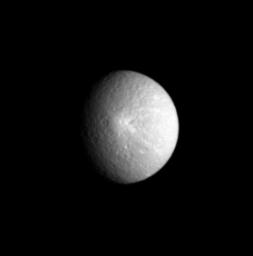
|
Rhea’s Bright Splat
- Click the image above for a larger view
- Full-Res JPEG (279 x 282) (3.0 kB)
- Full-Res TIFF (279 x 282) (79.0 kB)
Caption:
Saturn's moon Rhea displays one of its more prominent features here: a bright, rayed crater which was seen at much higher resolution in an image taken two weeks earlier. Rhea is 1,528 kilometers (949 miles) across.
North on Rhea is up and rotated about 65 degrees to the left. This view shows principally the anti-Saturn hemisphere on Rhea.
The image was taken in visible light with the Cassini spacecraft narrow-angle camera on April 27, 2005, at a distance of approximately 2 million kilometers (1.3 million miles) from Rhea and at a Sun-Rhea-spacecraft, or phase, angle of 42 degrees. The image scale is 12 kilometers (7 miles) per pixel.
Background Info:
The Cassini-Huygens mission is a cooperative project of NASA, the European Space Agency and the Italian Space Agency. The Jet Propulsion Laboratory, a division of the California Institute of Technology in Pasadena, manages the mission for NASA's Science Mission Directorate, Washington, D.C. The Cassini orbiter and its two onboard cameras were designed, developed and assembled at JPL. The imaging team is based at the Space Science Institute, Boulder, Colo.
For more information about the Cassini-Huygens mission visit http://saturn.jpl.nasa.gov . For additional images visit the Cassini imaging team homepage http://ciclops.org .
Cataloging Keywords:
| Name | Value | Additional Values |
|---|---|---|
| Target | Rhea | Saturn |
| System | Saturn | |
| Target Type | Satellite | Planet |
| Mission | Cassini-Huygens | |
| Instrument Host | Cassini Orbiter | |
| Host Type | Orbiter | |
| Instrument | Imaging Science Subsystem (ISS) | |
| Detector | Narrow Angle Camera | |
| Extra Keywords | Crater, Grayscale, Rotation, Visual | |
| Acquisition Date | ||
| Release Date | 2005-06-06 | |
| Date in Caption | 2005-04-27 | |
| Image Credit | NASA/JPL/Space Science Institute | |
| Source | photojournal.jpl.nasa.gov/catalog/PIA07514 | |
| Identifier | PIA07514 | |
